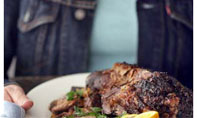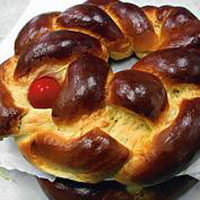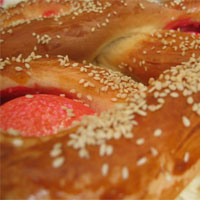- About Us
- Columns
- Letters
- Cartoons
- The Udder Limits
- Archives
- Ezy Reading Archive
- 2024 Cud Archives
- 2023 Cud Archives
- 2022 Cud Archives
- 2021 Cud Archives
- 2020 Cud Archives
- 2015-2019
- 2010-2014
- 2004-2009
 |
Ezy Reading: The Tsoureki/Babka Easter Bread Recipe |

With Easter now fast approaching, this time of year always conjures up for me memories of amazing food. Like I suppose it is for many families, Easter is yet another one of those celebrations where folks gather together, enjoy some time away from work and the regular routine, and, as at Christmas -amid different individual’s varying degrees of credence to the actual religious and spiritual aspects of the holiday- eat well.
I’m not talking about chocolate here, which was always more of a passing thought for me at Easter. Instead, especially as someone of Greek and Polish heritage, I’m talking about memories of huge table spreads loaded with culinary delights from each country. Bright, dyed-red hard-boiled eggs which would be cracked as per the custom in a flurry of activity among the family, seasonal breads and biscuits whose aromas had circulated throughout the house the day before during baking, kielbasa sausage, cabbage, cheese and potato-stuffed pierogis, tzatziki dip, Greek salad and, of course, always, slow-roasted lamb with lemon and oregano– each and every dish coming together in a head-on collision of two vastly different European cuisines. Collision or not, I certainly don’t ever recall anyone complaining about the food after yet another satisfying Easter breakfast or lunch.
One of the key elements in any Greek and Polish Easter feast is the seasonal bread similar to both cultures. Known as tsoureki in Greece, and as babka in Poland, it is, I suppose, somewhat like a brioche, light and sweet, but dependent upon various chef's specific tastes and preferences for as to whether or not it will be an especially soft or firm bread. Traditionally, the bread contains one or more dyed-red hard-boiled eggs still in their shell placed within the dough prior to baking to symbolize the blood of Christ and rebirth.
 Here, for those of you willing to brave at your own risk the perils of turning your kitchen into a sea of flour and sticky dough, is my mother Marcia’s recipe. Over the years I've encountered variations on the tsoureki/babka bread to feature such added ingredients as orange juice, rose water, anise and cinnamon, and, sometimes, as in my mother’s recipe, you may see the outside of the bread finished with blanched almonds and sesame seeds as well. Enjoy!
Here, for those of you willing to brave at your own risk the perils of turning your kitchen into a sea of flour and sticky dough, is my mother Marcia’s recipe. Over the years I've encountered variations on the tsoureki/babka bread to feature such added ingredients as orange juice, rose water, anise and cinnamon, and, sometimes, as in my mother’s recipe, you may see the outside of the bread finished with blanched almonds and sesame seeds as well. Enjoy!
TSOUREKIA/POLISH BABKA BREAD RECIPE (Plain):
3 envelopes yeast powder or 2 ozs. fresh yeast
½ cup warm water
1 cup warm milk
1 teaspoon sugar
10-12 cups of plain flour
6 eggs (+1 for glaze)
1 ½ cups sugar
1 tablespoon vanilla (liquid)
1 cup melted butter (or half butter/half margarine)
Colour-dyed hard-boiled eggs (as needed)
- Dissolve yeast in warm water.
- Add warm milk, 1 teaspoon sugar and 2 cups flour. Stir, cover, set in warm place for 1 hour until batter becomes double in size and bubbly.
- Beat 6 eggs, sugar and vanilla over hot water. Add melted butter slowly. Stir mixture into yeast batter. Add remaining flour using a wooden spoon, reserving 1 cup for kneading. Mix until mixture comes away from bowl, then tip onto a floured surface and knead. Knead until elastic.
- Place in a large buttered bowl and brush lightly with melted butter. Cover with a cloth and let it rise in a warm place until double – about 2 hours.
- Cut dough into 3 even-sized portions and shape each portion – into a loaf or braid each portion loosely. Place each portion onto a greased baking pan and cover. Let rise for 1 hour.
- Brush each bread with beaten egg and press one hard-boiled egg into the dough and sprinkle sesame seeds or sliced almonds and granulated sugar and bake in a moderate oven (350F/180C) for 25-30 mins.
